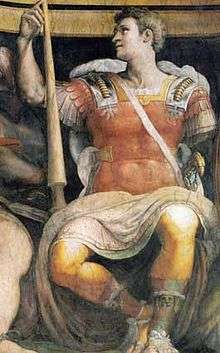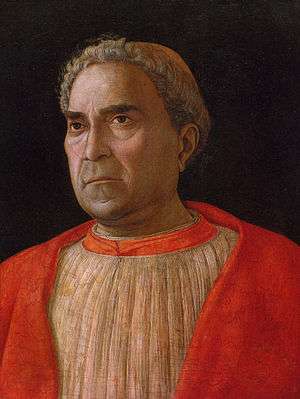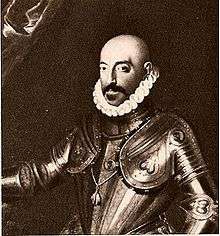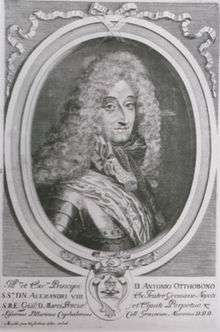Captain General of the Church
The Captain General of the Church (Italian: Capitano generale della Chiesa) was the de facto commander-in-chief of the papal armed forces during the Middle Ages. The post was usually conferred on an Italian or other noble with a professional military reputation or (later) a relative of the pope. The parallel office of Gonfalonier of the Church was more a formal and ceremonial honor than the responsibility of a tactical military leader.[1] Pope Innocent XII removed both ranks and replaced them with the position of Flag-bearer of the Holy Roman Church (Italian: Vessilifero di Santo Romana Chiesa), which later became hereditary in the Naro Patrizi.[2]
It was traditional for the Captain General to carry a baton of command, blessed by the pope.[3]
List of Captains General
- This list is incomplete; you can help by expanding it.
| Captain General | Portrait | Appointing Pope | Notes |
|---|---|---|---|
| Charlemagne* |  |
Leo III (798-816) |
"It is safest to conclude that the pope desired that the royal patrician should regard himself as captain-general of the church, and that he should in that capacity be entitled to the military services of its subjects, when called on by the church to interfere for the protection of her temporary rights."[4] |
| Guillaume Durand |  |
Martin IV (1281-1285) | [5] |
| James II of Aragon |  |
Boniface VIII (1294-1303) |
Gonfalonier, Admiral, and Captain General of the Church; compelled to wage war against his own brother (c.f. Sicilian Vespers)[6][7] |
| Philip VI of France |  |
Benedict XII (1334-1342) | Circa August 1336[8] |
| Juan Fernández de Heredia |  |
Innocent VI (1352-1362) | [9] |
| Daniele del Carretto | Gregory XI (1370-1378) | [10] | |
| Carlo I Malatesta |  |
Boniface IX (1389-1404) |
"temporary vicar and captain-general of the church"[11] |
| Braccio da Montone |  |
Gregory XII (1406-1415) | Appointed in 1414; "Used the army nominally belonging to the Pope to conquer Perugia for himself"[12] |
| Ranuccio Farnese il Vecchio |  |
Eugene IV (1431-1447) |
Appointed 1435; grandfather of Pope Paul III[13] |
| Niccolò Piccinino |  |
Appointed June 6, 1442; Condottiero; also the commander of the Duke of Milan's forces and thus "one of the first concrete indications" of the alliance between the pope and Milan[14] | |
| Jacques Cœur | Nicholas V (1447-1455) | Died as Captain General[15] | |
| Ludovico Trevisan |  |
Callixtus III (1455-1458) | Trevisan played an important role in organizing the naval campaign against the Ottomans in December 1455, both responsible for the construction of the papal navy and appointed "apostolic legate, governor general, captain and general condottiere" in charge of it.[16] |
| Giovanni I Ventimiglia, Marquess of Geraci (1445 and 1455) | |||
| Pedro Luis de Borja | Also Prefect of Rome[17] Not to be confused with Pedro Luis de Borja Lanzol de Romaní | ||
| Antonio Piccolomini | Pius II (1458-1464) |
Son of the sister of Pius II; lay relative; salary of 2000 ducats a year and castellan of Castel Sant'Angelo; hereditary principate as Duke of Amalfi, conferred through King Ferrante, an office held by later papal relatives as well[18] | |
| Girolamo Riario |  |
Sixtus IV (1471-1484) |
Pazzi conspirator; brother of cardinal-nephew Pietro Riario;[19] title later removed[20] |
| Franceschetto Cybo | Innocent VIII (1484-1492) | Illegitimate son of Innocent VIII[21] | |
| Roberto Eustachio | Former condottiero for Milan; led the campaign against Alfonso of Calabria; later returned to the service of the Republic of Venice[22] | ||
| Niccolò di Pitigliano (Orsini) |  |
Appointed June 27, 1489, in the midst of a conflict with Ferrante[23] | |
| Giovanni Borgia |  |
Alexander VI (1492-1503) |
Son; also Duke of Gandia and Gonfalonier; assassinated, perhaps by his brother Cesare[24] |
| Cesare Borgia |  |
Son; former cardinal-nephew, also Gonfalonier; often accused of Giovanni's assassination,[25] either directly or indirectly.[26] Julius II, the "Warrior Pope", refused to confirm Cesare upon his election.[27] | |
| Francesco Maria I della Rovere |  |
Julius II (1503-1513) |
Son of Julius II's brother, Giovanni, and the adopted heir of Guidobaldo, Duke of Urbino;[28] retained for one year after Julius II's death, paid 13,844 ducats plus a 30,000 ducat allowance for his company of 200 men-at-arms and 100 light cavalry[29] |
| Giuliano di Lorenzo de' Medici |  |
Leo X (1513-1521) |
Giuliano's son Giulio (future Pope Clement VII) was papal legate to the army[30] |
| Lorenzo II de' Medici, Duke of Urbino |  |
Appointed after the death of Giuliano in 1516; initially commanded the papal army in the War of Urbino (1517)[31] | |
| Bernardo Dovizi |  |
Appointed after the wounding of Lorenzo; commanded the papal army in the War of Urbino (1517) | |
| Federico II, Duke of Mantua |  |
Son of Isabella d'Este; also Gonfalonier; did not intervene in the Sack of Rome (1527)[32] | |
| Adrian VI (1522-1523) | |||
| Francesco Maria I della Rovere | Clement VII (1523-1535) |
Reappointed by Clement VII after his Dukedom had been stripped by Leo X and then reinstated by Adrian IV[33] | |
| Pier Luigi Farnese |  |
Paul III (1534-1549) |
Appinted February 2, 1537l; son of Paul III and former Gonfaloniere (appointed January 1535); held both titles simultaneously[34] |
| Giambattista del Monte | Julius III (1550-1555) |
Nephew of Julius III[35] | |
| Guidobaldo II della Rovere |  |
[36] | |
| Giovanni Carafa | Paul IV (1555-1559) | Appointed after the resignation of Guidobaldo; nephew of Paul IV; allegedly "affable and incompetent"[36] | |
| Marcantonio Colonna |  |
Gregory XIII (1572-1585) | Led the papal fleet during the Battle of Lepanto (1571)[37] |
| Taddeo Barberini |  |
Urban VIII (1623-1644) |
Brother of cardinal-nephew Antonio Barberini[38] |
| Livio Odescalchi |  |
Innocent XI (1676-1689) | Nephew of Innocent XI; also Gonfalonier[39] |
| Antonio Ottoboni |  |
Alexander VIII (1689-1691) | [40] |
See also
- Captain General, for similarly named ranks
- Gonfalonier of the Church
- Condottieri
- Papal States
Notes
- ↑ Chambers, 2006, p. 28.
- ↑ Levillain, Philippe. The Papacy: An Encyclopedia. "Heraldry." Accessed 5 June 2010.
- ↑ Chambers, 2006, p. 142.
- ↑ The Historians' History of the World. 1909. p. 662.
- ↑ Ronny O. Bodine and Thomas W. Spalding. 1995. The Ancestry of Dorothea Poyntz, Wife of Reverend John Owsley: Generations 1-12. R.O. Bodine & T.W. Spalding, Jr. p. 140.
- ↑
 "Pope Boniface VIII" in the 1913 Catholic Encyclopedia.
"Pope Boniface VIII" in the 1913 Catholic Encyclopedia. - ↑ Michele Amari, Francis Egerton Ellesmere. 1850. History of the War of the Sicilian Vespers. R. Bentley. p. 64.
- ↑ Jonathan Simon Christopher Riley-Smith, Jonathan Riley-Smith. 2005. The Crusades: A History. Continuum International Publishing Group. ISBN 0-8264-7270-2. p. 267.
- ↑ H. J. A. Sire. 1994. The Knights of Malta. Yale University Press. ISBN 0-300-06885-9. p. 42.
- ↑ Paul R. Thibault. 1987. Pope Gregory XI: The Failure of Tradition. University Press of America. ISBN 0-8191-5462-8. p. 64.
- ↑ Encyclopaedia Britannica. 1911. "Rome". p. 681.
- ↑ June Osborne, Joe Cornish. 2002. Urbino: The Story of a Renaissance City. Frances Lincoln Ltd. ISBN 0-7112-2086-7. p. 45.
- ↑ Chambers, 2006, p. 162.
- ↑ Joachim W. Stieber. 1978. Pope Eugenius IV, the Council of Basel and the Secular and Ecclesiastical Authorities in the Empire. BRILL. ISBN 90-04-05240-2. p. 195.
- ↑ MacMillan's Magazine. "A King's Treasurer". p. 320.
- ↑ Chambers, 2006, p. 49.
- ↑ Maria Bellonci. 1939. The Life and Times of Lucrezia Borgia. Harcourt, Brace. p. 15.
- ↑ Chambers, 2006, p. 59.
- ↑ New Schaff-Herzog Encyclopedia. 1911. Funk and Wagnalls Company. p. 446.
- ↑ Levillain, Philippe. 2002. The Papacy: An Encyclopedia. p. 799.
- ↑ John William Bradley. 1888. A Dictionary of Miniaturists, Illuminators, Calligraphers, and Copyists. B. Quaritch. p. 291.
- ↑ Julia Mary Cartwright Ady. 1920. Beatrice D'Este, Duchess of Milan, 1475-1497: A Study of the Renaissance. E. P. Dutton & co. p. 43.
- ↑ Pastor, Ludwig. 1902. The History of the Popes. K. Paul, Trench, Trübner & Co., Ltd. p. 276.
- ↑ Spinosa, La saga dei Borgia.
- ↑ Eliakim Littell, Making of America Project, Robert S. Littell. 1888. The Living Age. Living Age Co. p. 70.
- ↑ Chambers's Encyclopaedia: A Dictionary of Universal Knowledge. "Borgia". 1901. J.B. Lippincott Company. p. 329.
- ↑ The New Encyclopaedia Britannica. 1983. p. 42.
- ↑ Chambers, 2006, pp. 14-15.
- ↑ James Dennistoun. 1851. Memoirs of the Dukes of Urbino. Longman, Brown, Green, and Longmans. p. 340.
- ↑ Chambers, 2006, p. 137.
- ↑ [Apostolo Zeno, Piercaterino Zeno] (1721) Giornale de' letterati d'Italia, Tomo trentesimoterzo, parte I (volume 33, part 1). In Venezia MDCCXXI: Appresso Gio. Gabbriello Hertz. Con licenza de' superiori, e privilegio anche di N.S Clemente XI. (in Italian) p. 246. Accessed May 2013.
- ↑ Christopher Hare, Marian Andrews, Baldassarre Castiglione. 1908. Courts & camps of the Italian renaissance. C. Scribner's Sons. p. 131.
- ↑ Chambers, 2006, p. 148.
- ↑ Chambers, 2006, p. 153.
- ↑ Chambers, 2006, p. 163.
- 1 2 Setton, Kenneth M. 1984. The Papacy and the Levant: 1204 - 1571. DIANE Publishing. ISBN 0-87169-162-0. p. 643.
- ↑ Hugh Bicheno. 2004. Crescent and Cross: The Battle of Lepanto 1571. Sterling Publishing Company, Inc. ISBN 1-84212-753-5. p. 159.
- ↑ Chambers, 2006, p. 176.
- ↑ http://www.mcsearch.info/record.html?id=101019
- ↑ Edward J. Olszewski. 2004. Cardinal Pietro Ottoboni (1667-1740) and the Vatican Tomb of Pope Alexander VIII. DIANE Publishing. ISBN 0-87169-252-X. p. 111.
References
- Chambers, D.S. 2006. Popes, Cardinals & War: The Military Church in Renaissance and Early Modern Europe. I.B. Tauris. ISBN 1-84511-178-8.